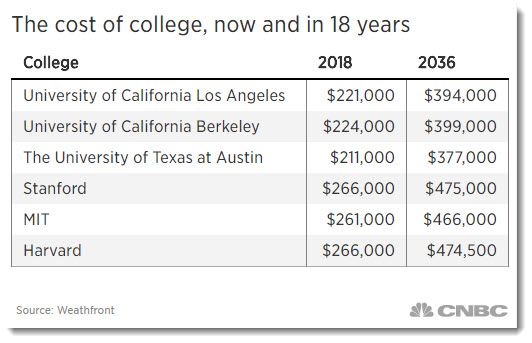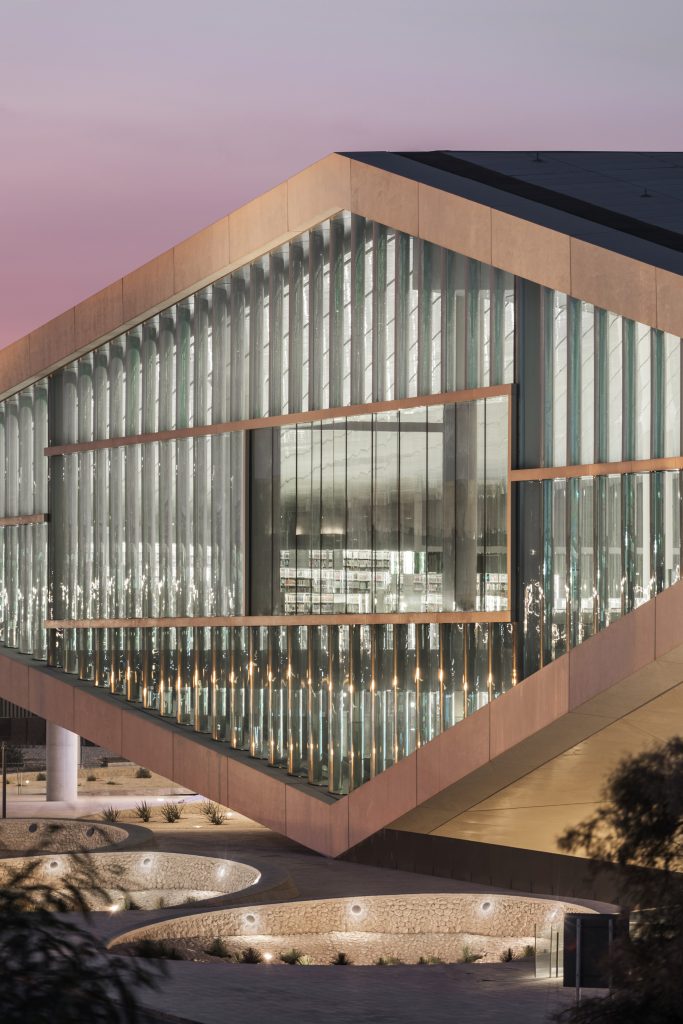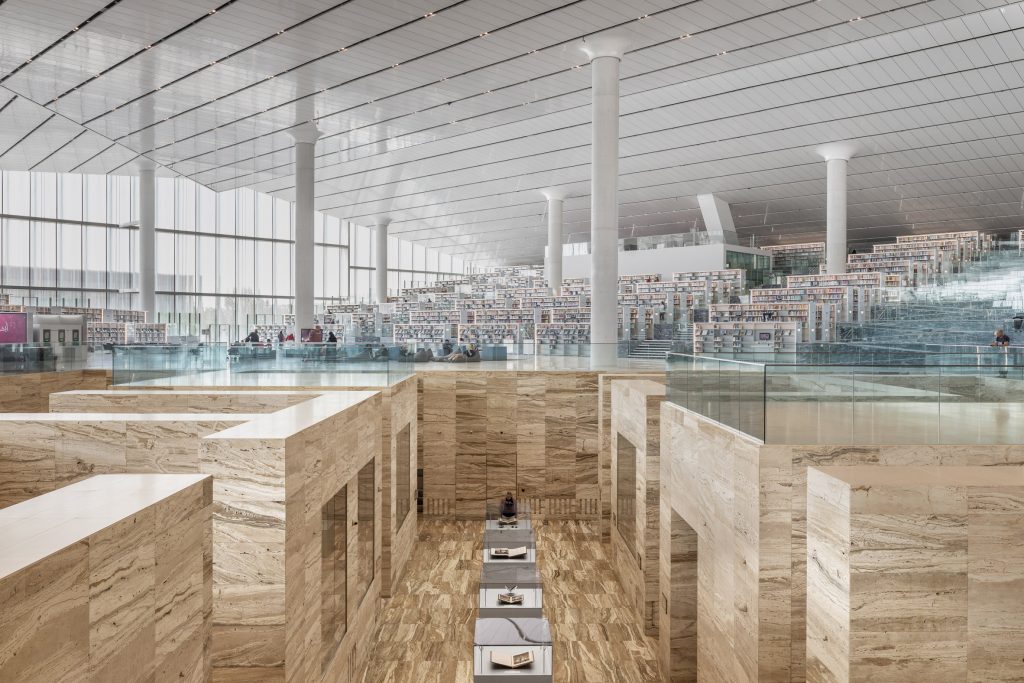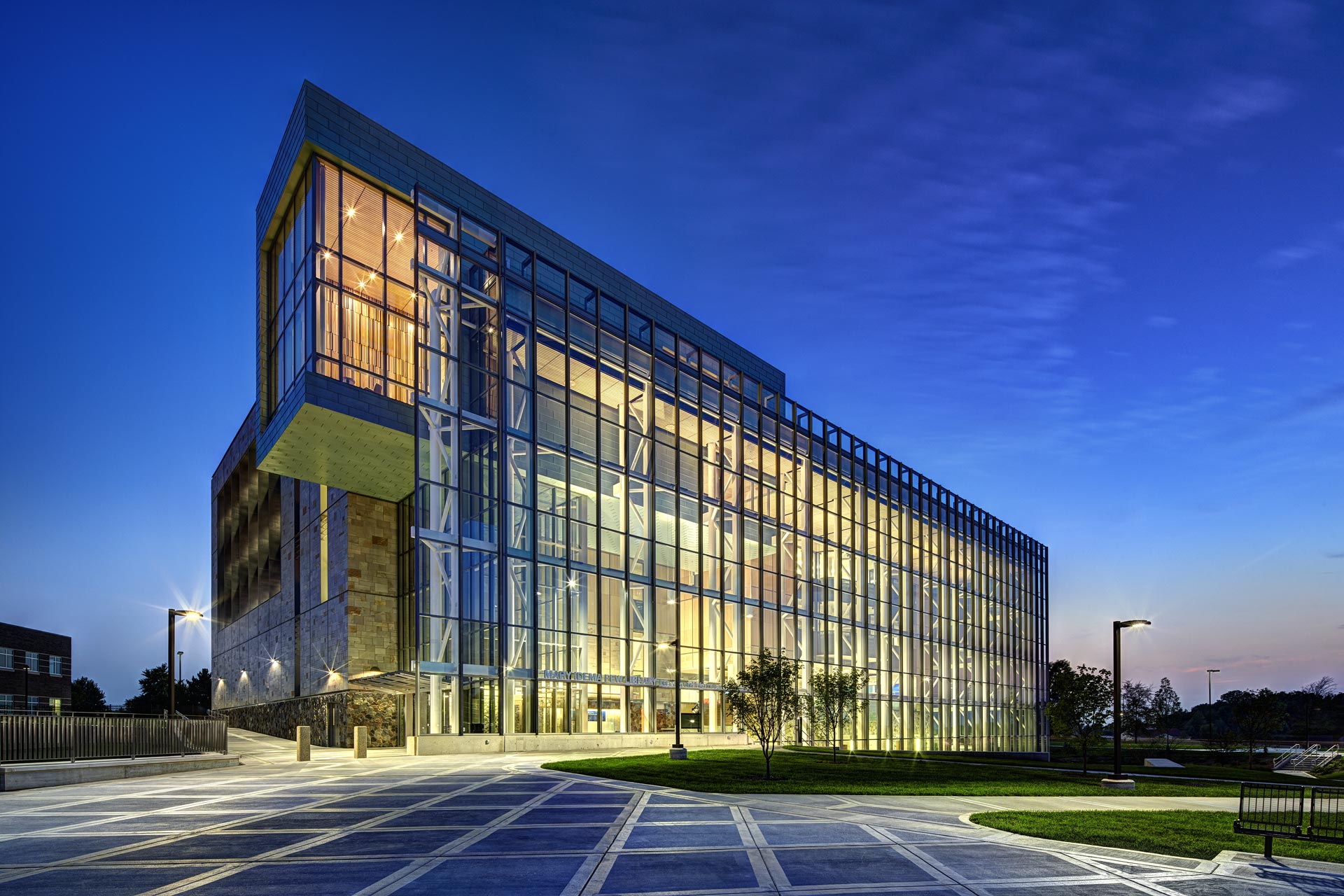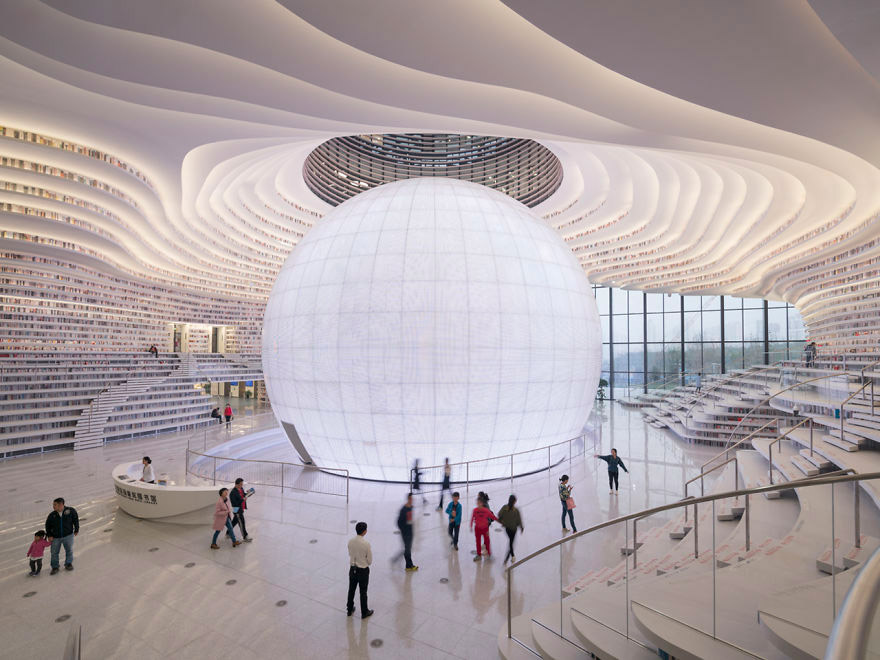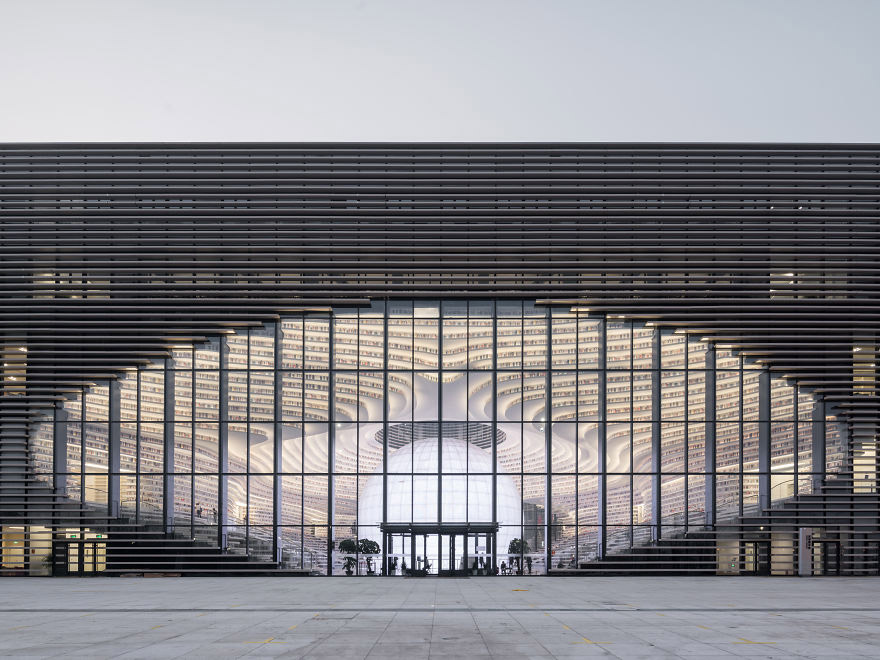A giant book-shaped library — from fubiz.net
Cambridge library installation gives readers control of their sensory space — from cambridge.wickedlocal.com by Hannah Schoenbaum
Excerpts:
A luminous igloo-shaped structure in the front room of the Cambridge Public Library beckoned curious library visitors during the snowy first weekend of March, inviting them to explore a space engineered for everyone, yet uniquely their own.
Called “Alterspace” and developed by Harvard’s metaLAB and Library Innovation Lab, this experiment in adaptive architecture granted the individual control over the sensory elements in his or her space. A user enters the LED-illuminated dome to find headphones, chairs and an iPad on a library cart, which displays six modes: Relax, Read, Meditate, Focus, Create and W3!Rd.
From the cool blues and greens of Relax mode to a rainbow overload of excitement in the W3!Rd mode, Alterspace is engineered to transform its lights, sounds and colors into the ideal environment for a particular action.
From DSC:
This brings me back to the question/reflection…in the future, will students using VR headsets be able to study by a brook? An ocean? In a very quiet library (i.e., the headset would come with solid noise cancellation capabilities build into it)? This type of room/capability would really be helpful for our daughter…who is easily distracted and doesn’t like noise.
From a fairly recent e-newsletter from edsurge.com — though I don’t recall the exact date (emphasis DSC):
New England is home to some of the most famous universities in the world. But the region has also become ground zero for the demographic shifts that promise to disrupt higher education.
This week saw two developments that fit the narrative. On Monday, Southern Vermont College announced that it would shut its doors, becoming the latest small rural private college to do so. Later that same day, the University of Massachusetts said it would start a new online college aimed at a national audience, noting that it expects campus enrollments to erode as the number of traditional college-age students declines in the coming years.
“Make no mistake—this is an existential threat to entire sectors of higher education,” said UMass president Marty Meehan in announcing the online effort.
The approach seems to parallel the U.S. retail sector, where, as a New York Times piece outlines this week, stores like Target and WalMart have thrived by building online strategies aimed at competing with Amazon, while stores like Gap and Payless, which did little to move online, are closing stores. Of course, college is not like any other product or service, and plenty of campuses are touting the richness of the experience that students get by actually coming to a campus. And it’s not clear how many colleges can grow online to a scale that makes their investments pay off.
“It’s predicted that over the next several years, four to five major national players with strong regional footholds will be established. We intend to be one of them.”
University of Massachusetts President Marty Meehan
From DSC:
That last quote from UMass President Marty Meehan made me reflect upon the idea of having one or more enormous entities that will provide “higher education” in the future. I wonder if things will turn out to be that we’ll have more lifelong learning providers and platforms in the future — with the idea of a 60-year curriculum being an interesting idea that may come into fruition.
Long have I predicted that such an enormous entity would come to pass. Back in 2008, I named it the Forthcoming Walmart of Education. But then as the years went by, I got bumbed out on some things that Walmart was doing, and re-branded it the Forthcoming Amazon.com of Higher Education. We’ll see how long that updated title lasts — but you get the point. In fact, the point aligns very nicely with what futurist Thomas Frey has been predicting for years as well:
“I’ve been predicting that by 2030 the largest company on the internet is going to be an education-based company that we haven’t heard of yet,” Frey, the senior futurist at the DaVinci Institute think tank, tells Business Insider. (source)
I realize that education doesn’t always scale well…but I’m thinking that how people learn in the future may be different than how we did things in the past…communities of practice comes to mind…as does new forms of credentialing…as does cloud-based learner profiles…as does the need for highly efficient, cost-effective, and constant opportunities/means to reinvent oneself.
Also see:
- Fearing ‘existential threat,’ U of Massachusetts unveils plans for national online platform — from educationdive.com by Natalie Schwartz
Addendum:
74% of consumers go to Amazon when they’re ready to buy something. That should be keeping retailers up at night. — from cnbc.com
Key points (emphasis DSC)
- Amazon remains a looming threat for some of the biggest retailers in the country — like Walmart, Target and Macy’s.
- When consumers are ready to buy a specific product, nearly three-quarters of them, or 74 percent, are going straight to Amazon to do it, according to a new study by Feedvisor.
- By the end of this year, Amazon is expected to account for 52.4 percent of the e-commerce market in the U.S., up from 48 percent in 2018.
“In New England, there will be between 32,000 and 54,000 fewer college-aged students just seven years from now,” Meehan said. “That means colleges and universities will have too much capacity and not enough demand at a time when the economic model in higher education is already straining under its own weight.” (Marty Meehan at WBUR)
From DSC:
In a next generation learning system, it would be sharp/beneficial to have a Netflix-like interface to check out potential functionalities that you could turn on and off (at will) — as one component of your learning ecosystem that could feature a setup located in your living room or office.
For example, put a Netflix-like interface to the apps out at eduappcenter.com (i.e., using a rolling interface at first, then going to a static page/listing of apps…again…similar to Netflix).
Want to retire and then hit the books? 10 great college towns for retirees — from cnbc.com by Kenneth Kiesnoski
Excerpt:
- Kalamazoo, Michigan
University: Western Michigan University
There’s plenty to do in Kalamazoo, such as visits to Bell’s Brewery, the Kalamazoo Air Zoo, the Gilmore Car Museum and the W.K. Kellogg Bird Sanctuary. The city of some 75,000 is also home to four campuses of Western Michigan University. Budget-wise, Kalamazoo is easy on retiree pocketbooks; GoBankingRates found that Michigan residents pay 10.3 percent less, on average, for common living expenses than other Americans.
Also see:
WMU a leader in offering learning by virtual reality — from wmich.edu by Deanna Puca
Excerpt:
KALAMAZOO, Mich.—Travel the world for history class and actually see the culture. Practice surgery or accurately design a 3D car.
Western Michigan University offers significant opportunities in the areas of teaching, learning and research at one of the largest virtual reality laboratories at an institution of higher education.
The VR Lab at WMU Libraries was started to explore this revolutionary technology as a collaborative effort of the Office of Information Technology and Waldo Library. Opening the door to broad collaborative possibilities and feeding the curiosities of varied audiences, users have experienced both the entertainment and educational side of VR content in the lab’s first year.
“Libraries are in a huge state of change with technology,” says Lou Ann Morgan, senior marketing specialist for University Libraries.
From DSC:
I have often reflected on differentiation or what some call personalized learning and/or customized learning. How does a busy teacher, instructor, professor, or trainer achieve this, realistically?
It’s very difficult and time-consuming to do for sure. But it also requires a team of specialists to achieve such a holy grail of learning — as one person can’t know it all. That is, one educator doesn’t have the necessary time, skills, or knowledge to address so many different learning needs and levels!
- Think of different cognitive capabilities — from students that have special learning needs and challenges to gifted students
- Or learners that have different physical capabilities or restrictions
- Or learners that have different backgrounds and/or levels of prior knowledge
- Etc., etc., etc.
Educators and trainers have so many things on their plates that it’s very difficult to come up with _X_ lesson plans/agendas/personalized approaches, etc. On the other side of the table, how do students from a vast array of backgrounds and cognitive skill levels get the main points of a chapter or piece of text? How can they self-select the level of difficulty and/or start at a “basics” level and work one’s way up to harder/more detailed levels if they can cognitively handle that level of detail/complexity? Conversely, how do I as a learner get the boiled down version of a piece of text?
Well… just as with the flipped classroom approach, I’d like to suggest that we flip things a bit and enlist teams of specialists at the publishers to fulfill this need. Move things to the content creation end — not so much at the delivery end of things. Publishers’ teams could play a significant, hugely helpful role in providing customized learning to learners.
Some of the ways that this could happen:
Use an HTML like language when writing a textbook, such as:
<MainPoint> The text for the main point here. </MainPoint>
<SubPoint1>The text for the subpoint 1 here.</SubPoint1>
<DetailsSubPoint1>More detailed information for subpoint 1 here.</DetailsSubPoint1>
<SubPoint2>The text for the subpoint 2 here.</SubPoint2>
<DetailsSubPoint2>More detailed information for subpoint 2 here.</DetailsSubPoint2>
<SubPoint3>The text for the subpoint 3 here.</SubPoint3>
<DetailsSubPoint3>More detailed information for subpoint 3 here.</DetailsSubPoint1>
<SummaryOfMainPoints>A list of the main points that a learner should walk away with.</SummaryOfMainPoints>
<BasicsOfMainPoints>Here is a listing of the main points, but put in alternative words and more basic ways of expressing those main points. </BasicsOfMainPoints>
<Conclusion> The text for the concluding comments here.</Conclusion>
<BasicsOfMainPoints> could be called <AlternativeExplanations>
Bottom line: This tag would be to put things forth using very straightforward terms.
Another tag would be to address how this topic/chapter is relevant:
<RealWorldApplication>This short paragraph should illustrate real world examples
of this particular topic. Why does this topic matter? How is it relevant?</RealWorldApplication>
On the students’ end, they could use an app that works with such tags to allow a learner to quickly see/review the different layers. That is:
- Show me just the main points
- Then add on the sub points
- Then fill in the details
OR - Just give me the basics via an alternative ways of expressing these things. I won’t remember all the details. Put things using easy-to-understand wording/ideas.
It’s like the layers of a Microsoft HoloLens app of the human anatomy:
Or it’s like different layers of a chapter of a “textbook” — so a learner could quickly collapse/expand the text as needed:
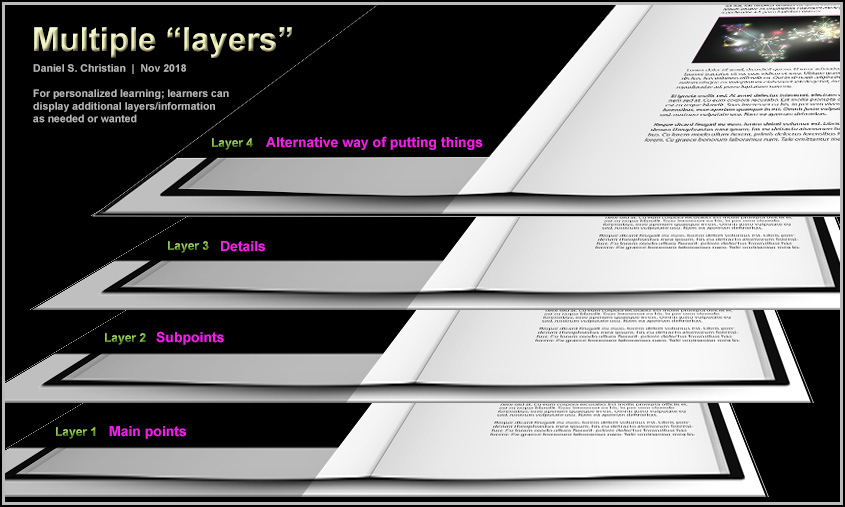
This approach could be helpful at all kinds of learning levels. For example, it could be very helpful for law school students to obtain outlines for cases or for chapters of information. Similarly, it could be helpful for dental or medical school students to get the main points as well as detailed information.
Also, as Artificial Intelligence (AI) grows, the system could check a learner’s cloud-based learner profile to see their reading level or prior knowledge, any IEP’s on file, their learning preferences (audio, video, animations, etc.), etc. to further provide a personalized/customized learning experience.
To recap:
- “Textbooks” continue to be created by teams of specialists, but add specialists with knowledge of students with special needs as well as for gifted students. For example, a team could have experts within the field of Special Education to help create one of the overlays/or filters/lenses — i.e., to reword things. If the text was talking about how to hit a backhand or a forehand, the alternative text layer could be summed up to say that tennis is a sport…and that a sport is something people play. On the other end of the spectrum, the text could dive deeply into the various grips a person could use to hit a forehand or backhand.
- This puts the power of offering differentiation at the point of content creation/development (differentiation could also be provided for at the delivery end, but again, time and expertise are likely not going to be there)
- Publishers create “overlays” or various layers that can be turned on or off by the learners
- Can see whole chapters or can see main ideas, topic sentences, and/or details. Like HTML tags for web pages.
- Can instantly collapse chapters to main ideas/outlines.
Top Trends in Active and Collaborative Learning — from thesextantgroup.com by Joe Hammett
Excerpts:
My daughter is a maker. She spends hours tinkering with sewing machines and slime recipes, building salamander habitats and the like. She hangs out with her school friends inside apps that teach math and problem solving through multi-player games. All the while, they are learning to communicate and collaborate in ways that are completely foreign to their grandparent’s generation. She is 10 years old and represents a shift in human cognitive processing brought about by the mastery of technology from a very young age. Her generation and those that come after have never known a time without technology. Personal devices have changed the shared human experience and there is no turning back.
The spaces in which this new human chooses to occupy must cater to their style of existence. They see every display as interactive and are growing up knowing that the entirety of human knowledge is available to them by simply asking Alexa. The 3D printer is a familiar concept and space travel for pleasure will be the norm when they have children of their own.
Current trends in active and collaborative learning are evolving alongside these young minds and when appropriately implemented, enable experiential learning and creative encounters that are changing the very nature of the learning process. Attention to the spaces that will support the educators is also paramount to this success. Lesson plans and teaching style must flip with the classroom. The learning space is just a room without the educator and their content.
…
8. Flexible and Reconfigurable
With floor space at a premium, classrooms need to be able to adapt to a multitude of uses and pedagogies. Flexible furniture will allow the individual instructor freedom to set up the space as needed for their intended activities without impacting the next person to use the room. Construction material choices are key to achieving an easily reconfigurable space. Raised floors and individually controllable lighting fixtures allow a room to go from lecture to group work with ease. Whiteboard paints and rail mounting systems make walls reconfigurable too!.
Active Learning, Flipped Classroom, SCALE-UP, TEAL Classroom, whatever label you choose to place before it, the classroom, learning spaces of all sorts, are changing. The occupants of these spaces demand that they are able to effectively, and comfortably, share ideas and collaborate on projects with their counterparts both in person and in the ether. A global shift is happening in the way humans share ideas. Disruptive technology, on a level not seen since the assembly line, is driving a change in the way humans interact with other humans. The future is collaborative.
Caselaw Access Project (CAP) Launches API and Bulk Data Service — from the Library Innovation Lab at the Harvard Law School Library by Kelly Fitzpatrick
Excerpt:
[On 10/29/18] the Library Innovation Lab at the Harvard Law School Library is excited to announce the launch of its Caselaw Access Project (CAP) API and bulk data service, which puts the full corpus of published U.S. case law online for anyone to access for free.
Between 2013 and 2018, the Library digitized over 40 million pages of U.S. court decisions, transforming them into a dataset covering almost 6.5 million individual cases. The CAP API and bulk data service puts this important dataset within easy reach of researchers, members of the legal community and the general public.
To learn more about the project, the data and how to use the API and bulk data service, please visit case.law.
Also see:
- Harvard Law Gives Public Free Access to Four Centuries of U.S. Court Cases — from thecrimson.com by Laura Espinoza and Katherine Li
Inside Amazon’s artificial intelligence flywheel — from wired.com by Steven Levy
How deep learning came to power Alexa, Amazon Web Services, and nearly every other division of the company.
Excerpt (emphasis DSC):
Amazon loves to use the word flywheel to describe how various parts of its massive business work as a single perpetual motion machine. It now has a powerful AI flywheel, where machine-learning innovations in one part of the company fuel the efforts of other teams, who in turn can build products or offer services to affect other groups, or even the company at large. Offering its machine-learning platforms to outsiders as a paid service makes the effort itself profitable—and in certain cases scoops up yet more data to level up the technology even more.
It took a lot of six-pagers to transform Amazon from a deep-learning wannabe into a formidable power. The results of this transformation can be seen throughout the company—including in a recommendations system that now runs on a totally new machine-learning infrastructure. Amazon is smarter in suggesting what you should read next, what items you should add to your shopping list, and what movie you might want to watch tonight. And this year Thirumalai started a new job, heading Amazon search, where he intends to use deep learning in every aspect of the service.
“If you asked me seven or eight years ago how big a force Amazon was in AI, I would have said, ‘They aren’t,’” says Pedro Domingos, a top computer science professor at the University of Washington. “But they have really come on aggressively. Now they are becoming a force.”
Maybe the force.
From DSC:
When will we begin to see more mainstream recommendation engines for learning-based materials? With the demand for people to reinvent themselves, such a next generation learning platform can’t come soon enough!
- Turning over control to learners to create/enhance their own web-based learner profiles; and allowing people to say who can access their learning profiles.
- AI-based recommendation engines to help people identify curated, effective digital playlists for what they want to learn about.
- Voice-driven interfaces.
- Matching employees to employers.
- Matching one’s learning preferences (not styles) with the content being presented as one piece of a personalized learning experience.
- From cradle to grave. Lifelong learning.
- Multimedia-based, interactive content.
- Asynchronously and synchronously connecting with others learning about the same content.
- Online-based tutoring/assistance; remote assistance.
- Reinvent. Staying relevant. Surviving.
- Competency-based learning.

We’re about to embark on a period in American history where career reinvention will be critical, perhaps more so than it’s ever been before. In the next decade, as many as 50 million American workers—a third of the total—will need to change careers, according to McKinsey Global Institute. Automation, in the form of AI (artificial intelligence) and RPA (robotic process automation), is the primary driver. McKinsey observes: “There are few precedents in which societies have successfully retrained such large numbers of people.”
Also relevant/see:
Online education’s expansion continues in higher ed with a focus on tech skills — from educationdive.com by James Paterson
Dive Brief:
- Online learning continues to expand in higher ed with the addition of several online master’s degrees and a new for-profit college that offers a hybrid of vocational training and liberal arts curriculum online.
- Inside Higher Ed reported the nonprofit learning provider edX is offering nine master’s degrees through five U.S. universities — the Georgia Institute of Technology, the University of Texas at Austin, Indiana University, Arizona State University and the University of California, San Diego. The programs include cybersecurity, data science, analytics, computer science and marketing, and they cost from around $10,000 to $22,000. Most offer stackable certificates, helping students who change their educational trajectory.
- Former Harvard University Dean of Social Science Stephen Kosslyn, meanwhile, will open Foundry College in January. The for-profit, two-year program targets adult learners who want to upskill, and it includes training in soft skills such as critical thinking and problem solving. Students will pay about $1,000 per course, though the college is waiving tuition for its first cohort.
What is a learning ecosystem? And how does it support corporate strategy? — from ej4.com by Ryan Eudy
Excerpt:
A learning ecosystem is a system of people, content, technology, culture, and strategy, existing both within and outside of an organization, all of which has an impact on both the formal and informal learning that goes on in that organization.
The word “ecosystem” is worth paying attention to here. It’s not just there to make the term sound fancy or scientific. A learning ecosystem is the L&D equivalent of an ecosystem out in the wild. Just as a living ecosystem has many interacting species, environments, and the complex relationships among them, a learning ecosystem has many people and pieces of content, in different roles and learning contexts, and complex relationships.
Just like a living ecosystem, a learning ecosystem can be healthy or sick, nurtured or threatened, self-sustaining or endangered. Achieving your development goals, then, requires an organization to be aware of its own ecosystem, including its parts and the internal and external forces that shape them.
From DSC:
Yes, to me, the concept/idea of a learning ecosystem IS important. Very important. So much so, I named this blog after it.
Each of us as individuals have a learning ecosystem, whether we officially recognize it or not. So do the organizations that we work for. And, like an ecosystem out in nature, a learning ecosystem is constantly morphing, constantly changing.
We each have people in our lives that help us learn and grow, and the people that were in our learning ecosystems 10 years ago may or may not still be in our current learning ecosystems. Many of us use technologies and tools to help us learn and grow. Then there are the spaces where we learn — both physical and virtual spaces. Then there are the processes and procedures we follow, formally and/or informally. Any content that helps us learn and grow is a part of that ecosystem. Where we get that content can change, but obtaining up-to-date content is a part of our learning ecosystems. I really appreciate streams of content in this regard — and tapping into blogs/websites, especially via RSS feeds and Feedly (an RSS aggregator that took off when Google Reader left the scene).
The article brings up a good point when it states that a learning ecosystem can be “healthy or sick, nurtured or threatened, self-sustaining or endangered.” That’s why I urge folks to be intentional about maintaining and, better yet, consistently enhancing their learning ecosystems. In this day and age where lifelong learning is now a requirement to remain in the workforce, each of us needs to be intentional in this regard.
The scary amount that college will cost in the future — from cnbc.com by Annie Nova
Excerpt:
Think college is expensive now? Then new parents will probably want to take a seat for this news.
In 2036, just 18 years from now, four years at a private university will be around $303,000, up from $167,000 today.
To get a degree at a public university you’ll need about $184,000, compared with $101,000 now.
These forecasts were provided by Wealthfront, an automated investment platform that offers college saving options. It uses Department of Education data on the current cost of schools along with expected annual inflation to come up with its projections.
Excerpted graphic:
From DSC:
We had better be at the end of the line of thinking that says these tuition hikes can continue. It’s not ok. More and more people will be shut out by this kind of societal gatekeeper. The ever-increasing cost of obtaining a degree has become a matter of social justice for me. Other solutions are needed. The 800 pound gorilla of debt that’s already being loaded onto more and more of our graduates will impact them for years…even for decades in many of our graduates’ cases.
It’s my hope that a variety of technologies will make learning more affordable, yet still provide a high quality of education. In fact, I’m hopeful that the personalization/customization of learning will take some major steps forward in the very near future. We will still need and want solid teachers, professors, and trainers, but I’m hopeful that those folks will be aided by the heavy lifting that will be done by some powerful tools/technologies that will be aimed at helping people learn and grow…providing lifelong learners with more choice, more control.
I love the physical campus as much as anyone, and I hope that all students can have that experience if they want it. But I’ve seen and worked with the high costs of building and maintaining physical spaces — maintaining our learning spaces, dorms, libraries, gyms, etc. is very expensive.
I see streams of content becoming more prevalent in the future — especially for lifelong learners who need to reinvent themselves in order to stay marketable. We will be able to subscribe and unsubscribe to curated streams of content that we want to learn more about. For example, today, that could involve RSS feeds and Feedly (to aggregate those feeds). I see us using micro-learning to help us encode information and then practice recalling it (i.e., spaced practice), to help us stop or lessen the forgetting curves we all experience, to help us sort information into things we know and things that we need more assistance on (while providing links to resources that will help us obtain better mastery of the subject(s)).
OMA’s Qatar National Library opens in Doha — from dezeen.com by India Block
Excerpt:
Dutch architecture firm OMA has completed its Qatar National Library building in Doha, which features tiers of marble bookcases set within a single open-plan space. The OMA-designed building, which opened earlier this week, houses several collections of Qatar’s most important texts and manuscripts on Arab-Islamic civilisation.
The Link to Content in 21st-Century Libraries — from er.educause.edu by Joan Lippincott
Excerpt (emphasis DSC):
At the 2017 Designing Libraries for the 21st Century annual conference, architect Craig Dykers asked the audience what he described as a rhetorical question: Are libraries places for information, with people in them, or are they places for people, with information in them? He concluded that ideally, today’s libraries, as they have always been, are places for the interaction of people, knowledge, and technologies. One reason that library renovations have brought record numbers of people into the physical building is that the notion of how people interact with content began to expand when available technologies were introduced to libraries in the 1990s. Two specific concepts motivated many of the changes in library spaces beginning at that time. First was the realization that libraries could become places for students and faculty to create content rather than places merely to access content. Second was an increased emphasis in higher education pedagogy on active, collaborative learning, in contrast to the traditional, passive lecture mode. These trends led to some pervasive changes in library space configurations, but sometimes the emphasis on information or content got lost along the way.
Architect Craig Dykers asked the audience what he described as a rhetorical question: Are libraries places for information, with people in them, or are they places for people, with information in them? He concluded that ideally, today’s libraries, as they have always been, are places for the interaction of people, knowledge, and technologies.
From DSC:
I agree with my friend and colleague, Mr. Eric Kunnen (Associate Director, eLearning and Emerging Technologies at GVSU), when he mentions on Twitter that it would have been good to highlight the beautifully done Mary Idema Pew Library Learning and Information Commons in this solid article.
From DSC:
Reading the item below prompted me to return to a thought/question that I’ve had several times now…in the future, will students be able to choose “where” they want to study? One of our daughters would probably be able to focus better if she were able to be transported to a place of her choosing — perhaps by a stream of running water.

Anyway, it’s an interesting thought/question to consider. It would certainly provide:

Thanks to VR, your office will resemble a tropical island — from thenextweb.com by Amber Leigh Turner
Excerpt:
For example, the idea of being able to teleport their employees to worlds outside of the office – including on a beach on an island a thousand miles away – may help boost employees’ productivity while reducing their stress level.
Mure VR, an Icelandic company, has found a way to integrate virtual reality with your work with the introduction of Breakroom. According to their website, “Breakroom is the way to turn your virtual reality headset into a multi-monitor system. You open a relaxing virtual environment and open your regular Windows applications as a floating 2D monitor within the virtual world. You are no longer limited by the physical computer monitor and can surround yourself with applications.”
Breakroom allows employees to escape workplaces by creating a workspace – such as on the beach, or in a park – that is stress-reducing, while tailored specifically to their needs. Becoming immersed in your work and blocking out the distractions that come with now-popular open office environments is a practical way that Mure VR is bringing virtual reality into the workplace.
Also here’s another application of virtual reality:
Using virtual reality to teach medical students empathy for elders — from unionleader.com by Gretchen Grosky
Excerpt:
“We are Alfred” is a pioneering virtual reality program where students don a headset to experience first-hand what it is like to be an older adult living with these common conditions.
Students at the University of New England College of Osteopathic Medicine in Maine – the state with the oldest population in the country – are among the first in the world to use this program as a means to learn empathy for their patients.
“We’re trying to get our students to understand the person-to-person approach of caring for people and working with people,” said Dr. Marilyn R. Gugliucci, professor and director of geriatrics education and research at the college. “We don’t want to just teach in a classroom. They’ve got to know people to help heal people.”










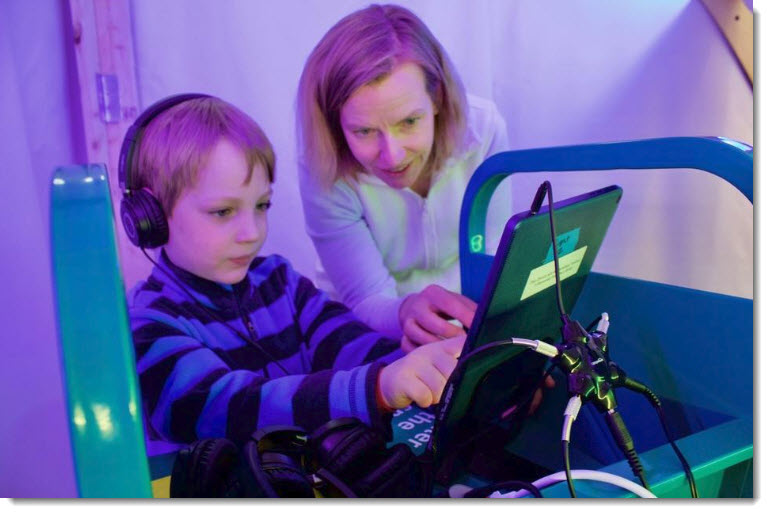

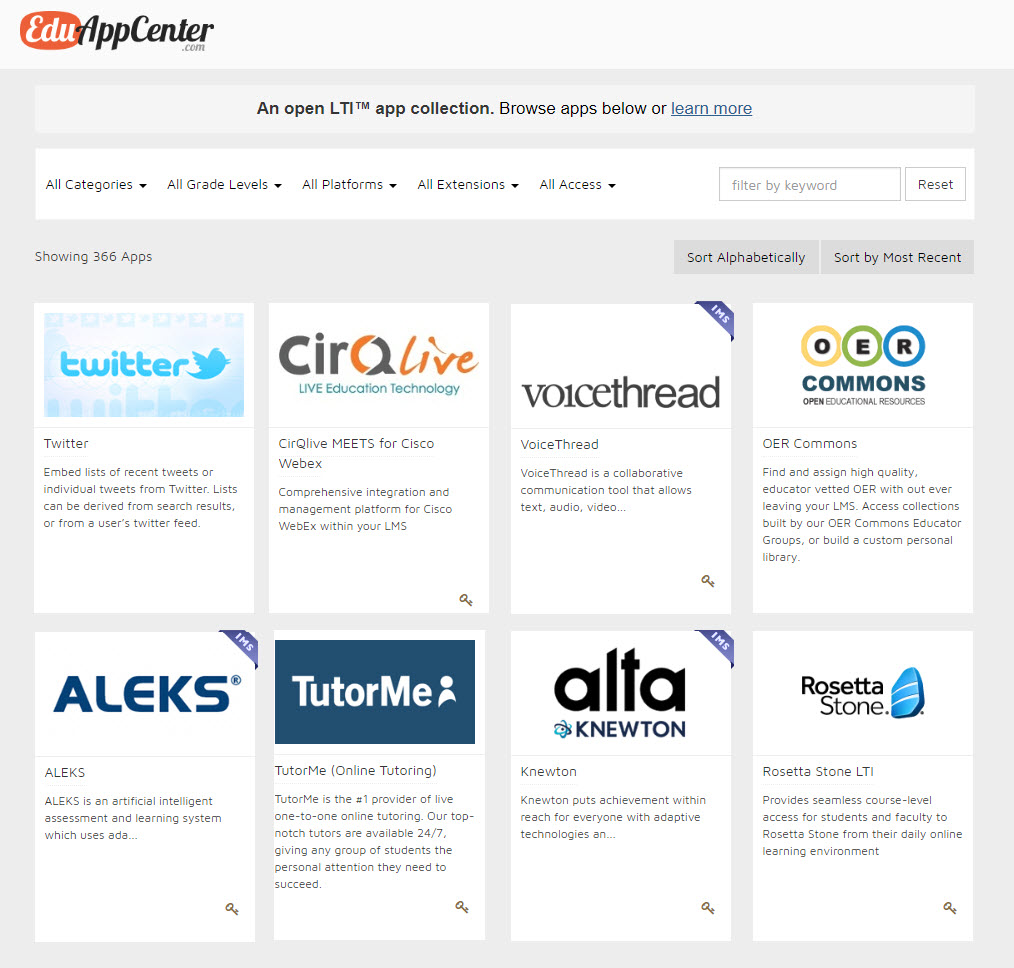

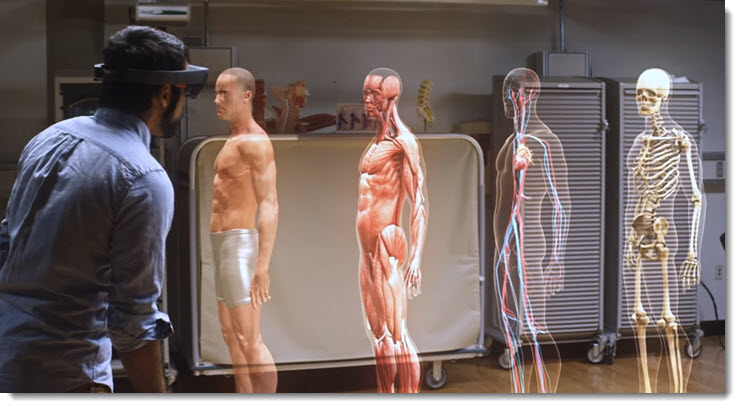

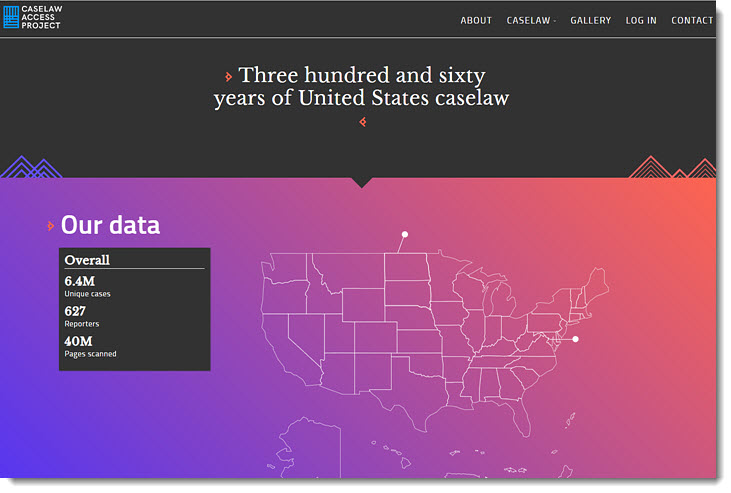
![The Living [Class] Room -- by Daniel Christian -- July 2012 -- a second device used in conjunction with a Smart/Connected TV](http://danielschristian.com/learning-ecosystems/wp-content/uploads/2012/07/The-Living-Class-Room-Daniel-S-Christian-July-2012.jpg)
